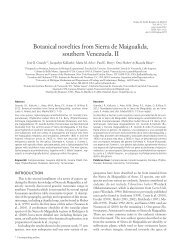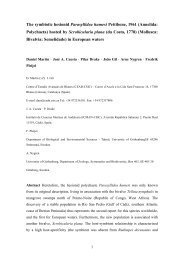Nuevos táxones animales descritos en la península Ibérica y - Csic
Nuevos táxones animales descritos en la península Ibérica y - Csic
Nuevos táxones animales descritos en la península Ibérica y - Csic
Create successful ePaper yourself
Turn your PDF publications into a flip-book with our unique Google optimized e-Paper software.
NUEVOS TÁXONES / NEW TAXA 257<br />
MATERIAL TIPO: holotipo (ST01C22) y dos paratipos (ST08C13) <strong>en</strong> el<br />
C<strong>en</strong>tre Mediterrani d’Investigacions Marines i Ambi<strong>en</strong>tals,<br />
Barcelona. Se m<strong>en</strong>ciona otros ocho paratipos (NBI6B8, NBI6B11)<br />
sin indiacción expresa del lugar de depósito.<br />
DISTRIBUCIÓN: mar Mediterráneo (cañones submarinos Foix, P<strong>la</strong>nier y<br />
Lacaze-Duthier)<br />
REFERENCIA: Sardá, R., Gil, J., Taboada, S. y Gili, J.M., 2009.<br />
Polychaete species captured in sedim<strong>en</strong>t traps moored in northwestern<br />
Mediterranean submarine canyons. Zoological Journal of<br />
the Linnean Society, 155(1): 1-21.<br />
*Ophryotrocha fabriae Paxton y Morineaux, 2009<br />
C<strong>la</strong>se Polychaeta, Familia Dorvilleidae<br />
LOCALIDAD TIPO: Lucky Strike hydrothermal v<strong>en</strong>t field, Mid-At<strong>la</strong>ntic<br />
Ridge, 1.620-1.730 m de profundidad.<br />
REFERENCIA: Paxton, H. y Morineaux, M., 2009. Three species of<br />
Dorvilleidae (Annelida: Polychaeta) associated with At<strong>la</strong>ntic<br />
deep-sea reducing habitats, with the description of Ophryotrocha<br />
fabriae, new species. Proceedings of the Biological Society of<br />
Washington, 122(1): 14-25.<br />
Paradoneis hirsuta Sardá, Gil, Taboada y Gili, 2009<br />
C<strong>la</strong>se Polychaeta, Familia Paraonidae<br />
LOCALIDAD TIPO: trap 10, cañón submarino Foix, mar Mediterráneo,<br />
Barcelona, 41°02’N, 01°56’E, 990 m de profundidad.<br />
MATERIAL TIPO: holotipo (ST01C22) <strong>en</strong> el C<strong>en</strong>tre Mediterrani<br />
d’Investigacions Marines i Ambi<strong>en</strong>tals, Barcelona.<br />
DISTRIBUCIÓN: conocida sólo por el holotipo.<br />
REFERENCIA: Sardá, R., Gil, J., Taboada, S. y Gili, J.M., 2009.<br />
Polychaete species captured in sedim<strong>en</strong>t traps moored in northwestern<br />
Mediterranean submarine canyons. Zoological Journal of<br />
the Linnean Society, 155(1): 1-21.<br />
ARACHNIDA<br />
Aelurilloida Maddison, Bodner y Needham, 2008<br />
Araneae, Familia Salticidae<br />
REFERENCIA: Maddison, W.P., Bodner, M.R. y Needham, K.M., 2008.<br />
Salticid spider phylog<strong>en</strong>y revisited, with the discovery of a <strong>la</strong>rge<br />
Austra<strong>la</strong>sian c<strong>la</strong>de (Araneae: Salticidae). Zootaxa, 1893: 49-64.<br />
NOTA: Nuevo c<strong>la</strong>do de Salticidae que incluye Aelurillini, Freyini y el<br />
grupo de géneros de Bace<strong>la</strong>rel<strong>la</strong>.<br />
Anapistu<strong>la</strong> ataecina Cardoso y Scharff, 2009<br />
Araneae, Familia Symphytognathidae<br />
LOCALIDAD TIPO: Gruta do Fumo, Sesimbra, Portugal, 38°26.050N,<br />
009°08.650W, 210 m.<br />
MATERIAL TIPO: holotipo (ZMUC000012700) y 15 paratipos<br />
(ZMUC000012701-707) <strong>en</strong> el Natural History Museum of<br />
D<strong>en</strong>mark, Zoological Museum, Universidad de Cop<strong>en</strong>hage.<br />
DISTRIBUCIÓN: Portugal.<br />
REFERENCIA: Cardoso, P. y Scharff, N., 2009. First record of the spider<br />
family Symphytognathidae in Europe and description of<br />
Anapistu<strong>la</strong> ataecina sp. n. (Araneae). Zootaxa, 2246: 45-57.<br />
Brachytydeus fernando Kazmierski, 2008<br />
Acari, Familia Tydeidae<br />
LOCALIDAD TIPO: Sierra de Guadarrama, Madrid (?), musgos <strong>en</strong> <strong>la</strong> base<br />
de un tronco de Quercus pyr<strong>en</strong>aica.<br />
MATERIAL TIPO: holotipo y seis paratipos <strong>en</strong> <strong>la</strong> colección del autor y un<br />
paratipo <strong>en</strong> el Zoological Museum, Hamburgo.<br />
DISTRIBUCIÓN: conocida sólo de <strong>la</strong> localidad tipo.<br />
REFERENCIA: Kazmierski, A., 2008. Description of two new species of<br />
Tydeinae (Acari: Actinedida: Tydeidae) from Spain with the<br />
remarks about the Iberian species of subfamily. Annales Zoologici<br />
(Warsaw), 58(2): 357-363.<br />
Brachytydeus matador Kazmierski, 2008<br />
Acari, Familia Tydeidae<br />
LOCALIDAD TIPO: Sierra de Guadarrama, Madrid (?), musgos <strong>en</strong> <strong>la</strong> base<br />
de un tronco de Quercus pyr<strong>en</strong>aica.<br />
MATERIAL TIPO: holotipo hembra y alotipo macho <strong>en</strong> <strong>la</strong> colección del autor.<br />
DISTRIBUCIÓN: conocida sólo de <strong>la</strong> localidad tipo.<br />
REFERENCIA: Kazmierski, A., 2008. Description of two new species of<br />
Tydeinae (Acari: Actinedida: Tydeidae) from Spain with the<br />
remarks about the Iberian species of subfamily. Annales Zoologici<br />
(Warsaw), 58(2): 357-363.<br />
*Cloacaroidea Bochkov y O’Connor, 2008<br />
Acari<br />
REFERENCIA: Bochkov, A.V. y O’Connor, B.M., 2008. A new mite<br />
superfamily Cloacaroidea and its position within the prostigmata<br />
(Acariformes). Journal of Parasitology, 94(2): 335-344.<br />
NOTA: Nueva superfamilia del infraord<strong>en</strong> Eleuther<strong>en</strong>g<strong>en</strong>a que incluye<br />
Cloacaridae y Epimyodicidae.<br />
Drassodex granja Hervé, Roberts y Murphy, 2009<br />
Araneae, Familia Gnaphosidae<br />
LOCALIDAD TIPO: La Granja, Segovia.<br />
MATERIAL TIPO: holotipo (Simon collection n° 23822, MNHN AR<br />
14601) y dos paratipos (MNHN AR 9256) <strong>en</strong> el Muséum National<br />
d’Histoire Naturelle, París.<br />
DISTRIBUCIÓN: alrededores de La Granja (Segovia).<br />
REFERENCIA: Hervé, C., Roberts, M.J. y Murphy, J.A., 2009. A taxonomic<br />
revision of the g<strong>en</strong>us Drassodex Murphy, 2007 (Araneae:<br />
Gnaphosidae). Zootaxa, 2171: 1-28.<br />
Erythraeus (Zaracarus) ruizporterae Mayoral y Barranco, 2008<br />
Acari, Familia Erythraeidae<br />
LOCALIDAD TIPO: P.N. Karst <strong>en</strong> Yeso de Sorbas, Almería.<br />
MATERIAL TIPO: holotipo <strong>en</strong> el Museo Nacional de Ci<strong>en</strong>cias Naturales,<br />
Madrid, y un paratipo <strong>en</strong> <strong>la</strong> colección de los autores.<br />
DISTRIBUCIÓN: conocida sólo de <strong>la</strong> localidad tipo.<br />
REFERENCIA: Mayoral, J.G. y Barranco, P., 2008. A new species of the<br />
g<strong>en</strong>us Erythraeus Latreille, 1806 (Acari: Erythraeidae) from the<br />
Gypsum Karst of Sorbas in the south of Spain. Revista <strong>Ibérica</strong> de<br />
Aracnología, [2007], 16: 113-117.<br />
Halodromus Muster, 2009<br />
Araneae, Familia Philodromidae<br />
ESPECIE TIPO: Ebo patellid<strong>en</strong>s Levy, 1977<br />
REFERENCIA: Muster, C., 2009. The Ebo-like running crab spiders in the Old<br />
World (Araneae, Philodromidae). ZooKeys, 16(Special Issue): 47-73.<br />
Halodromus barbarae Muster, 2009<br />
Araneae, Familia Philodromidae<br />
LOCALIDAD TIPO: Cartag<strong>en</strong>a, Murcia, 37°36’N, 0°59’W.<br />
MATERIAL TIPO: holotipo (MNHN ES 13388) y cinco paratipos <strong>en</strong> el<br />
Muséum National d’Histoire Naturelle, París; dos paratipos <strong>en</strong> el<br />
Muséum d’Histoire Naturelle, Ginebra; y uno <strong>en</strong> <strong>la</strong> Tel Aviv<br />
University.<br />
DISTRIBUCIÓN: Egipto, Israel, Arabia Saudí y España (Murcia). Los<br />
autores añad<strong>en</strong> (sic): “The species may also occur on the eastern<br />
Canary Is<strong>la</strong>nds. Schmidt and Krause (1996) illustrated the epigynum<br />
of a female from El Jable, Fuertev<strong>en</strong>tura (mounted epigynum<br />
lost, Schmidt and Krause 1996: 268) that they provisionally allocated<br />
to Ebo patel<strong>la</strong>ris, but they referred to differ<strong>en</strong>ces from the original<br />
description by Wunderlich (1987). This figure corresponds<br />
well to H. barbarae, while it certainly does not show H. patel<strong>la</strong>ris”.<br />
REFERENCIA: Muster, C., 2009. The Ebo-like running crab spiders in<br />
the Old World (Araneae, Philodromidae). ZooKeys, 16(Special<br />
Issue): 47-73.<br />
NOTA: urn:lsid:zoobank.org:act:994C72B5-39E7-4520-8902-31614C712<br />
6B5<br />
Heminothrinae Colloff y Cameron, 2009<br />
Acari, Familia Crotoniidae<br />
GÉNERO TIPO: Heminothrus Berlese, 1913<br />
Graellsia, 65(2), Diciembre 2009, pp. 249-280 — ISSN: 0367-5041

















